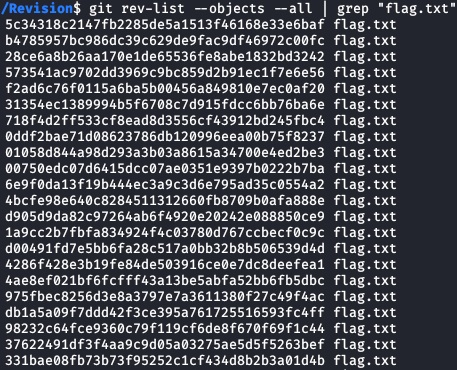Rating: 5.0
# Revision

## FLAG:
`RS{I_h0p3_y0u_scr1pted_th0s3_git_c0ms}`
#
## Solution
First you need to clone the repository through the command:
```git clone http://git.ritsec.club:7000/Revision.git```
So by running the command
```git rev-list --objects --all | grep "flag.txt"```
inside the directory that identifies the local copy of the repository, you can see the presence of 22 files:

```
import subprocess
flag = ""
with open("output.txt", "r") as f:
while "RS{" not in flag:
subprocess_return = subprocess.run(["git", "cat-file", "-p", f.readline().split(" ")[0]], stdout=subprocess.PIPE).stdout.decode().strip()
flag = subprocess_return + flag
print("[+] FLAG: " + flag)
```
i recovered the values corresponding to each object but, what you notice, is that the flag does not make much sense, in fact it turned out to be ``RS{Iyur1pedh3git_c0ms}``.
So I thought I'd see how many commits were referenced to the *flag.txt* file through the command: ``git log --abbrev-commit --pretty=oneline --all --full-history -- flag.txt`` and it emerged that the commits were 38.
From this i found two important information:
1. the flag contains 38 characters;
2. there are repeated characters that, with the previous command, were not shown.
At this point the game is done as i can identify the character through the commit and i have all the commits that refer to *flag.txt*.
After saving the result of the previous command in a file, i reprocessed the script in the following way and i recovered the correct flag.
```
import subprocess
flag = ""
f = open("all_chars_flag.txt", "r")
for line in f:
commit = line.split()[0]
arg1 = f"git ls-tree {commit} | grep \"flag.txt\""
subprocess_return = subprocess.run(arg1, shell=True, stdout=subprocess.PIPE).stdout.decode().strip().split()[2]
arg2 = f"git cat-file -p {subprocess_return}"
subprocess_return2 = subprocess.run(arg2, shell=True, stdout=subprocess.PIPE).stdout.decode().strip()
flag = subprocess_return2 + flag
print(f"[+] FLAG: {flag}")
f.close()
```